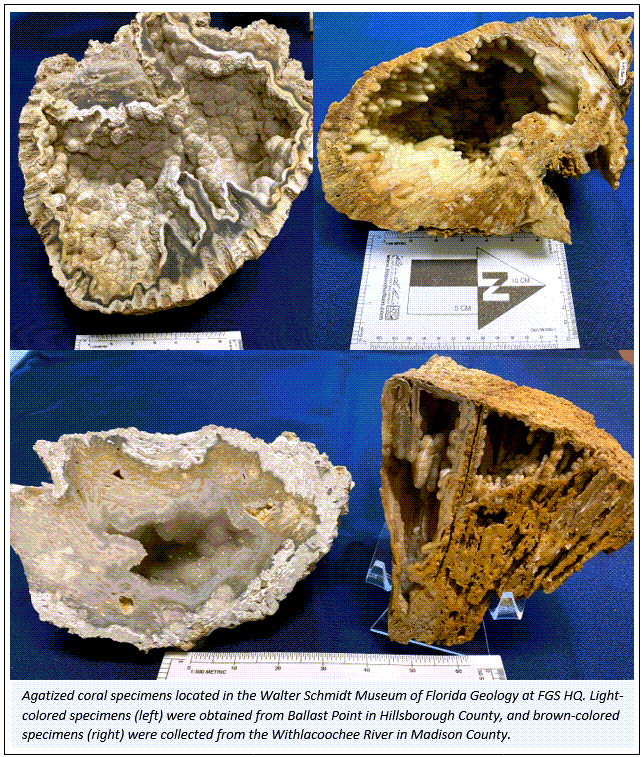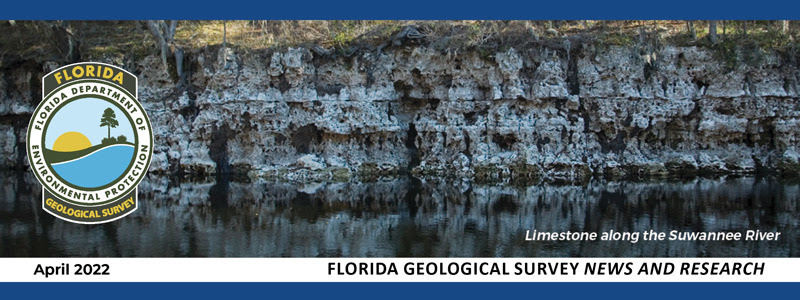Happy Earth Day and welcome to the April 2022 edition of FGS News and Research. Today, more than 1 billion people will celebrate Earth Day globally. This day was designated 52 years ago to mark the birth of the modern environmental movement. Floridians still face many environmental challenges, but we have accomplished much since Earth Day was established. Some of our environmental challenges in Florida are related to karst. I encourage you to learn more about karst landscapes as part of the National Park Service’s International Year of Caves and Karst. The celebration was organized to “help raise the level of understanding and respect for caves and karst as globally important physical, ecological and cultural systems.” Florida is one of the world’s most recognized locations for karst topography. An example of one of the most common features found in karst regions is Porter Hole Sink, one of the largest active sinkholes in Lake Jackson, located in Leon County. In Florida, many lakes formed as the result of sinkhole activity. Over geologic time, sinkholes collapse and form depressions on the land surface. These depressions can coalesce and expand and deepen the lake basin. Porter Hole Sink is one of many sinks in Lake Jackson and, when conditions are favorable, water in the lake can drain through it, leaving behind a dry lakebed. Lake Jackson has experienced multiple dry down events since June 2021. This natural process provided an opportunity for scientific study over the past year. The job of a geoscientist is dynamic and engaging. Florida’s geology is unique, fascinating, and more complicated than you might think! The following articles highlight some of the geologic wonders our state offers. Read about agatized corals and why they are important. Discover the complex mixture of limestone, fossil shell beds, quartz sand, and clay that makes up the Tamiami Formation. Learn about the geologic processes that create the breathtaking scenic views in Gold Head Branch and Ravine Gardens state parks. When I became a professional geologist (P.G.) many years ago, I never imagined I would one day serve as State Geologist. Part of my role as State Geologist is to designate State Geologic Sites in Florida that contain unique and vital geologic features. I recently had the pleasure of designating Torreya State Park as Florida’s newest State Geologic Site. My career as a P.G. has been fulfilling. Could a fascinating career as a P.G. be in your future? Learn more about how to become a professional geologist. Sincerely,  Guy H. Means, P.G. Administrator 
  GEOFACT: Agatized Corals of FloridaFlorida’s abundance of marine life stretches from the Gulf of Mexico down to the warm waters of the Florida Keys and around to the Atlantic Coast. Vital to Florida’s marine ecosystem, corals are one of the state's many aquatic organisms. What are corals and why are they important? Corals are marine invertebrates of the phylum Cnidaria that typically form compact colonies of individual polyps attached to hard, underwater surfaces. When alive underwater, these polyps combine their own carbon dioxide with the lime in warm seawater to form a limestone-like hard surface, or coral. Corals first appeared in the geologic record in the late Cambrian Period but didn’t become widespread until the Ordovician Period 100 million years later. Corals can be found throughout the world's oceans in both shallow and deep water. However, the reef-building corals that rely on a symbiotic relationship with algae need shallow, clear water to allow for light penetration for photosynthesis. According to the Florida Department of Environmental Protection’s Coral Reef Conservation Program, Florida’s coral reefs currently represent the third largest barrier reef ecosystem in the world. The reef tract in southern Florida extends 350 miles from the Dry Tortugas to the St. Lucie Inlet in Martin County. The only coral reef system in the continental United States, Florida's coral reef is home to over 40 species of reef-building corals that provide shelter, food and breeding sites for millions of plants and animals. What are agatized corals? Agatized corals form when the fossil voids of ancient, buried corals are filled with groundwater containing various forms of the mineral silica. These fossil voids are filled with forms of quartz, the primary one being chalcedony, whose translucent varieties are referred to as “agatized,” or “agate.” The agatized corals in Florida are roughly 20 to 30 million years old, demonstrating how much time the geologic transformation from coral to agatized coral can require. Agates are characterized by microcrystalline crystal sizes, banding, and rich coloration. Chalcedony is the most common variety of agate, but agatized corals may often exhibit rock crystal quartz, which occurs as delicate, white- to clear-colored, quartz crystal faces in void spaces in the coral. 
 Featured Formation - The Tamiami Formation
The Tamiami Formation is an important source of limestone, quartz sand, and fossil shell used for construction and road base in Southwest Florida. There are numerous pits and quarries where it is mined. The fossil shell beds in the Pincrest Sand are paleontologically significant and are known to contain one of the most diverse molluscan faunas in the world. It is estimated that between 800 and 1,200 different species of mollusks can be found in the Pincrest Sand. The chances are good that if you have decorative rocks in your yard that came from Southwest Florida, they are from the Tamiami Formation. See the following suggested references for more detailed information about the Tamiami Formation. Contact: Rick Green, P.G. III Selected References: Hunter, M.E., and Wise, S.W., Jr., 1980, Possible restriction and redefinition of the Tamiami Formation in South Florida: Points for further discussion in P.J. Gleason, ed./, Water, Oil, and the Geology of Collier, Lee, and Hendry counties: Miami Geological Society Field Trip Guidebook, 1980, p. 41-44.  Geology in ...the Real Florida ℠ - Gold Head Branch and Ravine Gardens State ParksMike Roess Gold Head Branch State Park and Ravine Gardens State Park contain intriguing examples of how geologic processes create captivating landscapes. Both parks have steephead ravines with ecosystems that are different from the surrounding uplands. Gold Head Branch State Park has sinkholes that resulted from dissolution of limestone in the subsurface. Steepheads are interesting geologic features found in locations scattered across northern Florida. Rainwater falls on the land surface and slowly infiltrates the sand to create the surficial aquifer system. Steephead ravines develop where surficial aquifer system groundwater seeps out of the ground along a contact between underlying low permeability sediment and overlying unconsolidated sand. As water flows from the seeps, sand is eroded and a steephead ravine begins to develop. Over time, erosion causes the head of the ravine to migrate headward into the higher hills and a larger steephead ravine is formed.  Mike Roess Gold Head Branch State Park Mike Roess Gold Head Branch State Park is located in the rolling hills of northern Florida in Clay County. The northern part of the park is part of the landscape feature known as the Trail Ridge Province, where greater elevations are observed. In contrast, the southern area of the park is part of the Hawthorne Lakes Province, where sinkholes are more common. The geologic story of the park begins with limestone found more than 200 feet below the land surface. The geologic formation known as the Ocala Limestone was deposited in a warm, shallow sea in the late Eocene Epoch nearly 34 million years ago. It is overlain by the Hawthorn Group, a lithostratigraphic unit. In northern Florida, the Hawthorn Group contains a mix of sand, clay, and carbonates (limestone and dolostone) that was deposited between 23 to 12 million years ago during the Miocene Epoch. Younger quartz sand deposits overlie the Hawthorn Group and form the land surface in Gold Head Branch State Park. Limestone dissolves in fresh, slightly acidic groundwater, forming cavities. When the cavities collapse, overlying sediments move downward to fill the void, allowing a sinkhole to develop at the land surface. Sinkhole lakes, like Sheeler Lake in the northern part of the park, may form. In the southern part of Gold Head Branch State Park, a large area of coalesced sinkholes (including Little Lake Johnson and Big Lake Johnson) forms a basin. The sinkhole basin is important in the development of the park’s signature landforms, the steephead ravines.
 Torreya State Park Named as Sixth State Geological SiteThe Florida Geological Survey (FGS) recently named Torreya State Park the sixth State Geological Site in Florida, recognizing the park’s unique geological features, educational value, connection to the local ecosystem, and cultural significance. Legislation authorizes Florida’s State Geologist to designate State Geologic Sites at “locations of great and continuing significance to the scientific study and public understanding of the geological history of the state” (377.075(4)(e), Florida Statutes). The Torreya State Park geologic site designation ceremony took place at the park, near Bristol, with a crowd of approximately 45 people. After the ceremony, FGS Director and State Geologist Guy “Harley” Means led a guided hike to explore geological features in the park.
 Lake Jackson Dry Down Events Over Past Year Present Research Opportunities
For more information about research and local activities related to Lake Jackson, see the Friends of Lake Jackson’s latest newsletter, the Lake Jackson Voice. Contact: Sarah Erb  | |||||||||||
View current newsletter online: https://content.govdelivery. |










No comments:
Post a Comment